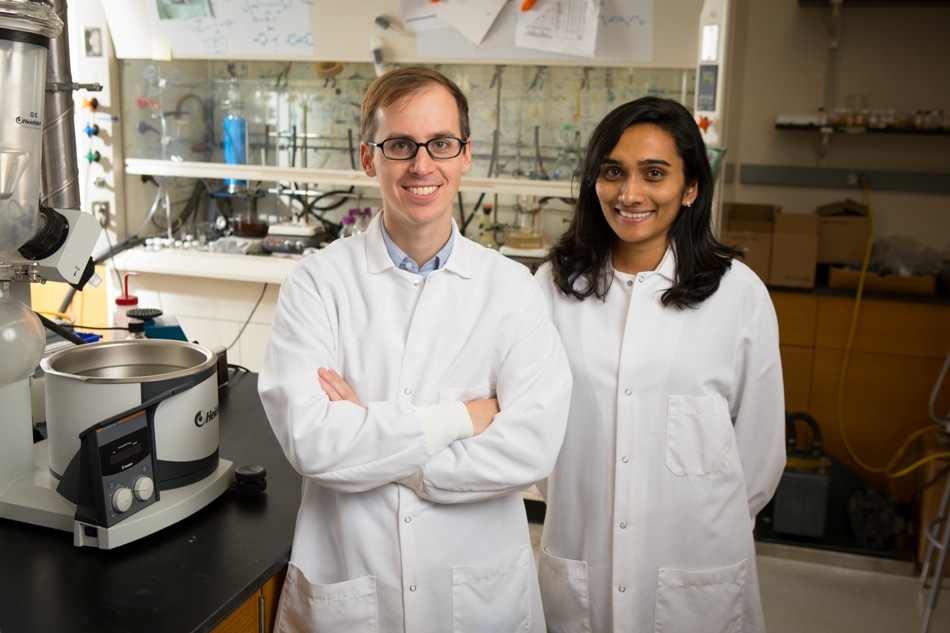Nov 18 2016
 The research team included Timothy Cook (left), UB assistant professor of chemistry, and first author Anjula M. Kosswattaarachchi, a UB PhD student in chemistry. Credit: Douglas Levere
The research team included Timothy Cook (left), UB assistant professor of chemistry, and first author Anjula M. Kosswattaarachchi, a UB PhD student in chemistry. Credit: Douglas Levere
Could a glow-in-the-dark dye be the next advancement in energy storage technology? Researchers from the University at Buffalo think so.
They have discovered a fluorescent dye named boron-dipyrromethene (BODIPY) as an ideal material for storing energy in rechargeable, liquid-based batteries that could power cars and homes in the future.
BODIPY glows brightly in the dark under a black light.
However, the traits that facilitate the storage of energy are less visible. According to the new study, the dye has interesting chemical properties that allow it to excel in storing and transferring electrons. Batteries have to perform these tasks in order to save and deliver energy, and the BODIPY dye is extremely good at them.
During the experiments, a BODIPY-based test battery worked efficiently and with longevity, and functioned well even after it was discharged and recharged 100 times.
As the world becomes more reliant on alternative energy sources, one of the huge questions we have is, 'How do we store energy?’ What happens when the sun goes down at night, or when the wind stops? All these energy sources are intermittent, so we need batteries that can store enough energy to power the average house.
Timothy Cook, PhD, Assistant Professor of Chemistry, University at Buffalo
The study was published in ChemSusChem, an academic journal dedicated to topics at the intersection of chemistry and sustainability, Nov. 16.
A Dye-Based Battery of the Future
BODIPY is a potential material for liquid-based batteries called “redox flow batteries.” These fluid-filled power cells offer several benefits over those made from standard materials.
According to Cook, lithium-ion batteries are very risky, as they can catch fire if they are ruptured. But the dye-based batteries would not have this issue, and if they are ruptured, they would only leak.
Redox flow batteries can be easily expanded to store more energy, allowing a homeowner to power a solar house during the night, or enabling a utility company to store wind energy for use during peak times, for example. This is very important because expanding the capacity has been a challenge for various other proposed battery technologies.
How BODIPY Works in a Battery
Redox flow batteries are made of two tanks of fluids that are separated by various barriers.
While the battery is being used, electrons are produced from one tank and transferred to the other, and they generate an electric current that could power small and large-scale devices, including flashlight and homes. In order to recharge the battery, a wind, solar, or other energy source would be used to force the electrons to go back into the original tank, from where they would do their job again.
The effectiveness of a redox flow battery depends on the fluids’ chemical properties in each tank.
The library of molecules used in redox flow batteries is currently small but is expected to grow significantly in coming years. Our research identifies BODIPY dye as a promising candidate.
Timothy Cook, PhD, Assistant Professor of Chemistry, University at Buffalo
In the study, Cook’s team filled the two tanks of a redox flow battery with PM 567, a powdered BODIPY dye dissolved in liquid.
Within the mixture, the BODIPY compounds exhibited a notable quality: they were able to yield and receive an electron without degrading as various other chemicals do. This feature allowed the dye to store electrons and improve their transfer between the two ends of the battery during repeated cycles of charging and discharging.
Based on their experiments, researchers predicted that the BODIPY batteries could generate an estimated 2.3 V of electricity that would provide enough power to a society.
According to Cook, the research focused on different varieties of BODIPY chemical properties, PM 567, so it’s likely that various other BOPIDY dyes could also become potential candidates for energy storage.
The research team included first author Anjula M. Kosswattaarachchi, a UB chemistry PhD student, and Alan Friedman, PhD, a UB research assistant professor in chemistry. The study was funded by UB, The Research Foundation for The State University of New York, and the National Center for Research Resources, part of the National Institutes of Health.
A Glow-in-the-Dark Battery Technology
University at Buffalo/Youtube.com